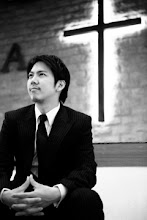最近一直努力地隱瞞一個小祕密, 因為還未到時機成熟, 無法跟大家說, 不過總算是到了要公佈這個祕密的時候啦......那就是~~~
鐺鐺鐺鐺---威廉要做爸爸囉!!! ^ ^
感謝主! 我跟以昕都很開心, 我們親愛的主耶穌在三個月前, 將這個 "新生命" 放在我們當中!!!
目前以昕懷孕剛滿13週, 因此還不知道究竟懷的是小威廉還是小以昕....(她比較想要是可愛的小男生, 我則是prefer貼心的小女生), 不過, 目前答案也只有我們的天父拔拔才知道囉~
無論是男是女, 我們都只希望他(她)能健康順利地在媽媽的肚子裡乖乖長大, 不要讓媽媽太辛苦囉.....
也請所有的弟兄姊妹跟家人朋友們為以昕的身體, 還有我們的小BABY禱告跟祝福喔~
在這也附上小以昕( ^o^ )的人生第一張照片, 與你們分享~
Hi! 歡迎來到William的薩克屋~
2011年3月12日 星期六
2011年3月7日 星期一
UNT Nine O'clock Jazz Lab Band的演出資訊(2011 Spring)
這學期William開始參加學校的Jazz Big Band, 雖然是從學校的9點鐘(9 o'clock) Jazz Lab band開始學習, 不過也是很棒的經驗喔~
(稍微跟大家解釋一下, 我們學校UNT一共有約11~12個Jazz的Big Band, 其中有九個是以"時鐘"來命名的, 最好的就是O'clock Lab Band, 他們也是在去年得到葛萊美獎提名中, 唯一的學生爵士大樂團喔~)
 這星期三晚上我們在Syndicate (UNT的Union的一樓)有一場正式的演出,
這星期三晚上我們在Syndicate (UNT的Union的一樓)有一場正式的演出,時間是晚上九點 (表演時間大約會是1個小時多一些~)
希望在Denton的同學朋友與弟兄姊妹有空的話,
請你們與朋友們一同前來欣賞~
William 雖然常常演出古典Concert,
不過與Jazz Big Band的表演, 在美國倒是第一次優!
到時現場若是有一些影音的紀錄, 在PO上來與大家分享吧~
2011年3月6日 星期日
UNT的Saxophone Departmental Recital
每一個禮拜, 在UNT的音樂系, 不同的樂器都有自己的Departmental Recital, 這個Departmental Recital 有點類似Studio Class, 就是會在一節課(50分鐘)內, 讓幾位同學上去演奏一首樂曲或是一個樂章~
不同於Studio Class的部份就是這只有演出而已, 而沒有老師講解或是大家交換建議, 所以真的有點像是正式的演出~ 不是該項樂器的同學也歡迎來參觀旁聽喔~
許多的樂器Departmental都是借用教室來演出, 不過我們學校由於有號稱將近100位左右的薩克斯風演奏者, 因此我們每週都是在我們的Recital Hall來進行我們的Departmental~
Departmental Recital 其實是一個不錯的idea, 可以增加一些演出的臨場經驗, 還可以從別人演奏的樂曲中有所學習~
William從上學期開始當學校的助教之後, 也都會一直鼓勵學生參加Departmental的演出, 自己也都會維持每學期 2-3 次的表演, 有時候是Solo, 有時候是二重奏或是四重奏的形態演出~
不過, 這個學期, 我的主修老師要求我們幾位助教必須要在Departmental準備一場演講(Lecture), 題目自訂, 時間大約是30分鐘左右~ 這個倒是讓我傷了一下腦筋, 畢竟要對著數十位薩克斯風手用英文演講關於薩克斯風演奏的專題, 還是跟我平時一對一的教學有些不同~
由於其他的幾位助教將會討論一些Saxohpone 演奏的特殊技巧像是循環呼吸, Slap, 或是Voicing之類的題目, 因此William決定回歸基本, 要在Departmental中與同學們分享一些關於指法的練習以及困難樂句的練習方式~
在此先將英文的hand out, 以及我將使用的影片Po上來, 之後有空在翻譯成中文, 並加上較為詳細的解釋跟大家分享囉~
Developing The Saxophone Technique and Practice Strategy
William Chien
Hand Position (Video Example)
a. Curved fingerings v.s Flat fingerings
b. Flying fingers v.s Fingers never leave the keys
c. Relax v.s Tense
d. Left-hand thumb --- Music Example 1
e. Left-hand pinky--- Low Bb-B-C-C#
f. Palm Keys (High D-D#-E-F-F#) --- Music Example 2
g. Coin Exercise --- All fingers must raise the same height
Music Example 1 (from Ferling Etude No.4- m2 and m4)
Music Example 2 (from Creston Sonata 3rd mvt)
Interval Exercise
Third, Fourth, Fifth, Sixth, Seventh, Octave and Above (Example 3)
Music Example 3 (from Carmen Fantaisie)
Alternate Fingerings
---Intonation, Tone Quality, Finger dexterity, Dynamic
a. Chromatic Exercises
b. Alternate F#, Bb fingering
c. High E and High F (Regular v.s Front Keys)
d. Side keys v.s Regular
e. Trill or Other fingering connections. (ex: Middle D to C#, Low G# to C#)
Music Example (from Bozza Caprice)
Mechanical Exercises
Difficult Fingering Combination Exercises
---Excerpt from the book Mechanical Exercise by Jean-Marie Londeix
Different articulation and Uneven Rhythmic Patterns
Music Example 5 (from Milhaud Scaramouche 1st mvt)
Method to practice Technique: Counting, Blowing, Fingering, Playing and Remembering – The James Campbell Approach
Step One:
Count sixteenth notes aloud in the tempo you wish to play a particular passage (1,2,3,4. 1, 2,3,4, etc.). Be sure that your tempo is relaxed and that you are relaxed counting in that tempo. The purpose of this step is designed to establish a comfortable tempo and even flow of sixteenth note counts in your mind.
Step Two:
While counting aloud, finger the particular passage on the saxophone (obviously, you will not be playing.) Be sure that you fingers are relaxed and curved. (Remember, you only need to use enough pressure to close the key; you do not need to squeeze the saxophone.)
Step Three:
Repeat step two from memory. While doing this, look at your fingers. Observe whether or not your fingers are relaxed curved. Eventually, try singing the pitches of the notes while counting.
Step Four:
Repeat step two, but instead of counting aloud, mentally maintain the pulse and blow a steady stream of warm air while you finger the passage. By doing this, you are connecting your air stream production to your technique as well as to your counting. Look at the music during this step.
Step Five:
Repeat step four from memory. You may need to shorten the technical passage and focus on one measure at a time.
Step Six:
Using the music, play the passage on the saxophone. Keep the even flow of sixteenth notes (from steps one and two) going in your mind while you play the passage. The steady stream of warm air practiced in the previous step should result in a well-supported sound in this step.
Step Seven:
Repeat step five from memory.
Reference
Londeix, Jean-Marie. Exercices Mecaniques (Mechanical Exercises For All Saxophones), Vol.1~3. Henry Lemoine, 1961
Londeix, Jean-Marie. The Scales by Steps and by Intervals. Henry Lemoine, 1962
Nestler, Eric. Saxophone Fundamentals, 6th edition, 2004
Teal, Larry. The Art of Saxophone Playing. Suzuki Method International, 1963
訂閱:
意見 (Atom)










